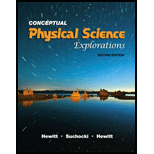
Which has stronger attractions among its submicroscopic particles: a solid at
Which one out of solid at
Answer to Problem 8TE
Solid at
Explanation of Solution
Forces of attraction in any kind of matter depends upon the distance between the molecules of matter. In solids the distance is least between adjacent molecules and hence the forces of attraction between them are maximum. Such high force of attraction among molecules are the reason why the solids are rigid in nature.
In gases molecules are far apart resulting in negligible forces of attraction among the molecules giving them very high fluidity (that is why we are able to move in atmosphere filled with gases).
Conclusion:
Therefore, molecules of solid at
Chapter 17 Solutions
Conceptual Physical Science Explorations
Additional Science Textbook Solutions
Conceptual Physics (12th Edition)
University Physics Volume 1
Tutorials in Introductory Physics
Conceptual Integrated Science
Lecture- Tutorials for Introductory Astronomy
Physics: Principles with Applications
 College PhysicsPhysicsISBN:9781305952300Author:Raymond A. Serway, Chris VuillePublisher:Cengage Learning
College PhysicsPhysicsISBN:9781305952300Author:Raymond A. Serway, Chris VuillePublisher:Cengage Learning University Physics (14th Edition)PhysicsISBN:9780133969290Author:Hugh D. Young, Roger A. FreedmanPublisher:PEARSON
University Physics (14th Edition)PhysicsISBN:9780133969290Author:Hugh D. Young, Roger A. FreedmanPublisher:PEARSON Introduction To Quantum MechanicsPhysicsISBN:9781107189638Author:Griffiths, David J., Schroeter, Darrell F.Publisher:Cambridge University Press
Introduction To Quantum MechanicsPhysicsISBN:9781107189638Author:Griffiths, David J., Schroeter, Darrell F.Publisher:Cambridge University Press Physics for Scientists and EngineersPhysicsISBN:9781337553278Author:Raymond A. Serway, John W. JewettPublisher:Cengage Learning
Physics for Scientists and EngineersPhysicsISBN:9781337553278Author:Raymond A. Serway, John W. JewettPublisher:Cengage Learning Lecture- Tutorials for Introductory AstronomyPhysicsISBN:9780321820464Author:Edward E. Prather, Tim P. Slater, Jeff P. Adams, Gina BrissendenPublisher:Addison-Wesley
Lecture- Tutorials for Introductory AstronomyPhysicsISBN:9780321820464Author:Edward E. Prather, Tim P. Slater, Jeff P. Adams, Gina BrissendenPublisher:Addison-Wesley College Physics: A Strategic Approach (4th Editio...PhysicsISBN:9780134609034Author:Randall D. Knight (Professor Emeritus), Brian Jones, Stuart FieldPublisher:PEARSON
College Physics: A Strategic Approach (4th Editio...PhysicsISBN:9780134609034Author:Randall D. Knight (Professor Emeritus), Brian Jones, Stuart FieldPublisher:PEARSON





